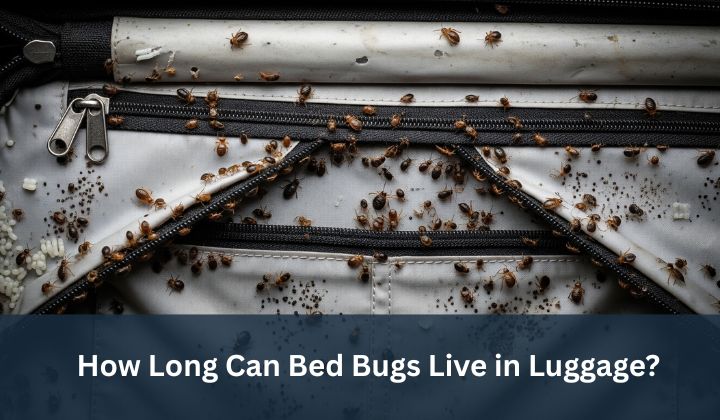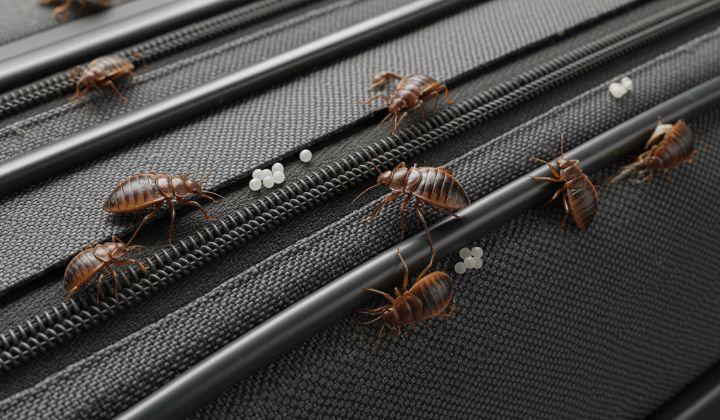Planning a trip and worried about how long can bed bugs live in luggage?
These tiny hitchhikers can turn a dream vacation into a nightmare by sneaking into your bags.

This guide dives into bed bug survival, prevention tips, and treatment methods to keep your luggage pest-free. From inspecting hotel rooms to cleaning suitcases, we’ll share expert advice and unique insights to ensure you return home with only good memories.
Understanding Bed Bug Behavior and Survival
Bed bugs are small, reddish-brown, oval-shaped insects that feed on human blood, typically at night.
They’re notorious hitchhikers, easily latching onto luggage, clothing, or personal items in hotels, planes, or public transport. Their flat bodies allow them to hide in seams, zippers, and folds of suitcases.
Without a blood meal, bed bugs can survive in luggage for months, with some sources suggesting up to a year in ideal conditions (cool, stable temperatures).
Their resilience makes early detection and prevention critical for travelers.
How Long Can Bed Bugs Live in Luggage?
Bed bugs can live in luggage for weeks to months without feeding, potentially up to a year in ideal conditions (cool, stable temperatures).
Adults are more resilient than nymphs, which need frequent meals. To prevent infestations, inspect luggage before bringing it home, use heat treatments (120°F for 20 minutes), or freeze items at 0°F for 4 days.
Seal clothes in plastic bags, vacuum suitcases, and avoid placing bags on beds or floors.
Why Bed Bugs Love Luggage

Luggage offers bed bugs dark, secluded hiding spots like seams, zippers, and pockets. Soft-sided suitcases are especially appealing due to their fabric texture, though hard-shell cases aren’t immune, as bugs can slip into crevices.
Bed bugs are drawn to carbon dioxide and body heat, making dirty clothes in luggage a prime target.
Their ability to survive long periods without feeding makes suitcases a perfect vehicle for spreading infestations, especially in high-traffic places like hotels or airports.
Preventing Bed Bugs While Traveling
To keep bed bugs out of your luggage, take these precautions:
- Inspect Hotel Rooms: Check mattresses, headboards, and furniture for dark spots, shed skins, or live bugs before unpacking. Use a flashlight for seams and crevices.
- Use Hard-Shell Luggage: Hard cases have fewer hiding spots than fabric bags, reducing bed bug risks.
- Keep Luggage Off Beds: Place bags on metal luggage racks or tiled floors (e.g., bathrooms) away from beds and upholstered furniture.
- Seal Clothes in Plastic: Store clothing in airtight or vacuum-sealed bags to limit bed bug access.
- Check Reviews: Research hotels for bed bug reports on travel forums or review sites before booking.
A unique tip: sprinkle diatomaceous earth inside your suitcase before traveling. This natural, non-toxic powder dehydrates bed bugs, acting as a preventive barrier rarely mentioned in other guides.
Inspecting Luggage for Bed Bugs
Upon returning home, inspect your luggage to prevent infestations:
- Choose a Hard Surface: Unpack on a non-carpeted, well-lit surface like a garage or tiled floor to spot bugs easily.
- Use a Flashlight: Check seams, zippers, pockets, and linings for live bugs, eggs, or dark fecal spots.
- Wear Protective Clothing: Use gloves and long sleeves to avoid transferring bugs to yourself.
- Bag Items Immediately: Place clothes in sealed plastic bags until they can be washed or treated.
A lesser-known trick: use a blacklight flashlight to detect bed bug excrement, which fluoresces under UV light, making it easier to spot in dark suitcase corners.
Treating Bed Bugs in Luggage
If you suspect bed bugs in your luggage, act quickly:
- Heat Treatment: Wash clothes in hot water (120°F or higher) and dry on high heat for at least 30 minutes. For non-washable items, use a dryer or portable heat chamber. Heat above 118°F kills bugs and eggs.
- Freezing: Place items in sealed bags and freeze at 0°F for 4 days to kill all life stages.
- Vacuuming: Vacuum luggage thoroughly, focusing on seams and crevices. Seal and dispose of the vacuum bag immediately.
- Steam Cleaning: Use a handheld steamer (at least 120°F) on luggage surfaces, especially seams, to kill bugs.
- Bed Bug Sprays: Apply non-toxic sprays (e.g., neem or tea tree oil) to luggage interiors and exteriors, following product instructions.
A novel insight: place luggage in a car on a hot day (above 120°F) with a thermometer to monitor temperature, ensuring all contents reach the lethal threshold for at least an hour.
Cleaning and Storing Luggage Post-Travel
After treating luggage, clean and store it properly:
- Wash with Hot Soapy Water: Scrub luggage with hot water and detergent, focusing on seams and zippers.
- Dry Thoroughly: Ensure luggage is completely dry to prevent mold, which can attract other pests.
- Store Away from Bedrooms: Keep suitcases in a garage, basement, or front closet, far from textiles where bed bugs thrive.
- Use Protective Covers: Encase luggage in bed bug-proof bags or plastic totes for added protection.
A unique tip: place dryer sheets or lavender sachets in stored luggage. Studies suggest bed bugs dislike these scents, adding an extra layer of deterrence.
Risks of Bringing Bed Bugs Home
Bringing bed bugs home can lead to:
- Infestations: A single bed bug can lay hundreds of eggs, spreading quickly through your home.
- Health Issues: Bites cause itchy welts, potential allergic reactions, and stress from infestations.
- Costly Treatments: Professional extermination can cost $1,000–$10,000, depending on severity.
- Property Damage: Replacing infested furniture or clothing adds to expenses.
A fresh insight: if you suspect exposure, quarantine luggage in a sealed plastic bag for several months, as bed bugs may survive longer than expected in cooler climates like Edmonton.
Unique Insights for Travelers
Pre-Trip Luggage Prep
Before packing, heat-treat your suitcase in a dryer at high heat for 30 minutes to eliminate any lingering bugs or eggs from past trips. This proactive step is rarely suggested but ensures a clean start.
Hotel Room Strategies
Avoid unpacking clothes into hotel drawers, even if they seem clean, as bed bugs can hide in furniture crevices. Live out of your suitcase on a metal rack to minimize risk.
Post-Travel Quarantine
If you can’t clean luggage immediately, seal it in a heavy-duty plastic bag and store it outside or in a garage for at least 6 months to outlast bed bug survival.
Natural Repellents
Sprinkle diatomaceous earth or use essential oil sprays (lavender, peppermint) in luggage. These natural deterrents are safe for humans but disrupt bed bug survival.
Public Transport Precautions
On planes, trains, or buses, keep luggage in overhead bins or away from seats to reduce exposure. Seal dirty clothes in plastic bags to avoid attracting bugs.
FAQs About How Long Can Bed Bugs Live in Luggage
1. How can I tell if my luggage has bed bugs?
Inspect luggage on a hard, well-lit surface using a flashlight. Look for live bugs (apple-seed-sized, reddish-brown), tiny white eggs, shed skins, or dark fecal spots in seams, zippers, and pockets.
Use a blacklight to detect fluorescent excrement. Vacuum thoroughly and seal the vacuum bag.
Wash clothes in hot water (120°F) and dry on high heat for 30 minutes. For hard-shell luggage, scrub with hot soapy water. Act quickly to prevent home infestations.
2. Can bed bugs survive a plane or train trip in luggage?
Yes, bed bugs can survive plane or train trips, as they endure months without feeding. Their small size and flat bodies let them hide in luggage seams or zippers.
To minimize risk, use hard-shell suitcases, seal clothes in plastic bags, and keep luggage off seats or floors.
Inspect bags before bringing them home, and heat-treat or freeze items to kill bugs. Avoid placing bags near infested areas like hotel beds.
3. How do I treat bed bugs in luggage at home?
Empty luggage outside or in a garage. Wash clothes in hot water (120°F) and dry on high heat for 30 minutes.
Vacuum luggage, focusing on seams, and dispose of the vacuum bag in a sealed plastic bag. Steam-clean at 120°F or freeze at 0°F for 4 days.
Apply non-toxic sprays like neem oil. For severe cases, consult a pest control professional to prevent home infestations.
4. Are hard-shell suitcases safer from bed bugs than soft-sided ones?
Hard-shell suitcases are safer, as they have fewer crevices for bed bugs to hide compared to fabric bags.
However, bugs can still slip into zippers or pockets. Heat-treat hard-shell luggage before trips and scrub with hot soapy water after.
Use diatomaceous earth inside for extra protection. Inspect thoroughly, as no luggage is fully immune. Store in a garage or sealed bag to minimize risks.
5. How long should I quarantine luggage to ensure bed bugs are gone?
Quarantine luggage in a sealed, heavy-duty plastic bag for at least 6–12 months in cool conditions, as bed bugs can survive up to a year without feeding.
For faster results, heat-treat at 120°F for 20 minutes or freeze at 0°F for 4 days.
Store luggage in a garage or basement, away from bedrooms. Vacuum and inspect regularly to confirm no bugs remain.
Practical Tips for Bed Bug-Free Luggage
- Choose Hard-Shell Luggage: Opt for smooth, hard cases to reduce hiding spots.
- Use Plastic Bags: Seal clothes in airtight bags during travel to limit bed bug access.
- Heat-Treat Before Trips: Run empty luggage through a dryer on high heat for 30 minutes.
- Inspect Regularly: Check luggage during and after trips, using a flashlight for seams and zippers.
- Store Smart: Keep luggage in a garage or sealed tote, far from bedrooms.
- Act Fast: If you suspect bed bugs, isolate luggage and treat immediately to prevent home infestations.
Conclusion
Curious about how long can bed bugs live in luggage? Bed bugs can survive weeks to a year in luggage without feeding, making prevention key.
Use hard-shell suitcases, seal clothes in plastic, and inspect hotel rooms to avoid hitchhikers.
Heat-treat or freeze luggage, vacuum thoroughly, and store away from bedrooms. These tips, paired with natural repellents like diatomaceous earth, ensure your travels stay pest-free, keeping your home safe from costly infestations.